
As a young child I remember my grandfather had a large map of somewhere called Zetland and the name fascinated me. It is of course the former name of the Shetland Islands. Having been to many of the Hebridean islands as well as Orkney I had wanted to visit Shetland for some time but Cecilia wasn’t keen because it seemed to be difficult to get to. Shetland lies about 50 miles north-east of Orkney but it is actually much easier to get to as the ferry departs from Aberdeen involving a much shorter drive. The ferry departs at 7pm so dinner on board followed by a good night’s sleep in a cabin before arriving in Lerwick at 7.30am. After parking the car in the terminal car park it’s time for breakfast on board before leaving the ferry to start the holiday.
We made our first trip to Shetland in 2003 and returned every year until 2006 staying in various self-catering properties in Ollaberry in Northmavine, Hamnavoe on Burra and Spiggie on South Mainland.
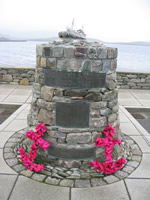
We returned to Shetland in 2018 staying in a cottage just outside Scalloway.
During WW2 Scalloway was the base for the Shetland Bus which was the nickname for a clandestine operation linking Shetland with occupied Norway using boats disguised as working fishing boats and the crew as fishermen.
One of the highlights of our first visit was the midnight boat trip to Mousa Island to visit the 12m high iron Age broch and see the storm petrels coming in to their nest sites in the walls. The sound they make is really eerie and you could imagine the broch was haunted if you were of that persuasion. The only downside to the trip was my camera broke as soon as we arrived.
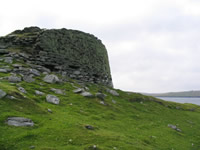 Shetland has many brochs scattered throughout the islands in various states of preservation but Mousa Broch is the tallest broch still standing and amongst the best-preserved prehistoric buildings in Europe, It is so well preserved that it was possible to climb the stairs within the walls to reach the top and look out over Mousa Sound.
Shetland has many brochs scattered throughout the islands in various states of preservation but Mousa Broch is the tallest broch still standing and amongst the best-preserved prehistoric buildings in Europe, It is so well preserved that it was possible to climb the stairs within the walls to reach the top and look out over Mousa Sound.
Other prehistoric sites include the Neolithic, horseshoe shaped Staneydale Temple which is situated in one of the few places on Mainland Shetland which is out of site of the sea. Another fascinating site is the Neolithic axe factory at Uyea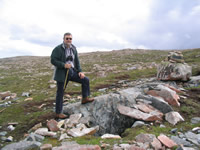 in North Roe where rough shaped axe heads were quarried out before being taken away for final polishing elsewhere. It’s a long trek from the nearest road and not the easiest place to find but very rewarding.
in North Roe where rough shaped axe heads were quarried out before being taken away for final polishing elsewhere. It’s a long trek from the nearest road and not the easiest place to find but very rewarding.
Being so close to Norway it is not surprising that there are so many signs of the Vikings’ presence on the islands. The most well known of course is Up Helly Aa but this was a Victorian creation.
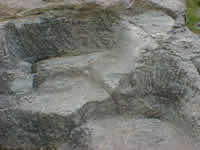
The most impressive archaeological evidence of the Vikings in Shetland is the soapstone quarry at Catpund on South Mainland. Soapstone or Steatite was used by the Vikings to make cooking vessels as it was fairly easily carved and it is possible to see the shape of bowls and other vessels where they have been cut out of the rock face. There are even some half-finished blanks which were never removed. It was well worth the climb! There is another Viking soapstone site at Fethaland at the tip of North Roe. Fethaland is a fabulous place with the remains of a prehistoric house behind the old haaf fishing station. Walking back along the coast takes you past the impressive Kame of Isbister which featured in the TV series Extreme Archaeology.
The coast at Eshaness is spectacular with the dramatic group of sea stacks called the Drongs just off the coast, the deep inlet of Calders Geo and the Holes of Scraada blowhole. The cliff tops are littered with huge boulders unbelievably deposited there from far below during the Atlantic storms which batter the coast.
The Sullom Voe oil terminal lies between Northmavine and North Mainland and is where much of the oil from rigs in the North Sea is brought ashore by pipeline and then stored and processed before being exported across the world by tanker. Ironically, the most expensive petrol I ever bought (costing about 20% more than at home) was from a petrol station only a couple of miles from the terminal.
At the opposite end of the island , at the tip of South Mainland, the cliffs below the lighthouse at Sumburgh Head are home to thousands of seabirds in the breeding season including guillemots, 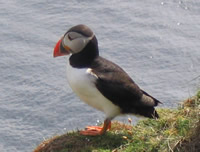 razorbills, shags and puffins. It’s one of the best places to get really close to puffins as many of their burrows are at the top of the cliffs just over the stone wall which surrounds the headland.
razorbills, shags and puffins. It’s one of the best places to get really close to puffins as many of their burrows are at the top of the cliffs just over the stone wall which surrounds the headland.
Sumburgh Airport lies below the headland and the main runway has been extended across the main road and barriers are lowered when a plane is due to land or take off. Signs warn drivers to keep straight on and not to turn off along the runway! Helicopters are a frequent sight, either ferrying oil workers to and from the rigs or the Coastguard search and rescue service.
Scatness Broch excavations are located alongside the main road next to the airport and the Prehistoric and Norse settlements at Jarlshof can be found a short distance further on across the road behind the Sumburgh Hotel.
Another attraction on South Mainland is the tombolo linking the mainland with St Ninian’s Isle near Bigton. It has recently featured in the BBC series “This Farming Life’ as St Ninian’s Isle is part of Bigton Farm, now run by the Budge sisters who took over the farm following the sudden death of their father in a tractor accident in 2014. In 2018 the sisters won the BBC Countryfile Farming Heroes award.
In recent years Shetland has featured quite a lot on TV including the BBC series An Island Parish about ministers on Unst, Island Medics about the team at the Gilbert Bain Hospital in Lerwick, and, of course, the detective series based on the Anne Cleaves’ books set in Shetland featuring the detective Jimmy Perez.
There is an excellent ferry service to the other islands in the archipelago. We have visited Yell and Unst most years but have found so much to see and do on Mainland that we haven’t made it to any of the others, although we did take the wildlife boat trip around the cliffs at Noss to see the seabird colonies from below. An amazing experience! As well as the wide variety of seabirds, cetaceans are a fairly common sight with orca and humpbacked whales being regular visitors around the coast.
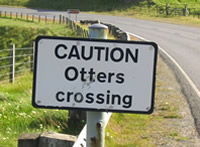 Another coastal resident is the otter which can be found all round the islands. One memorable siting was the otter which threaded its way between the cars waiting at the ferry terminal on Yell before it made its way down the embankment back into the sea.
Another coastal resident is the otter which can be found all round the islands. One memorable siting was the otter which threaded its way between the cars waiting at the ferry terminal on Yell before it made its way down the embankment back into the sea.
Shetland is also renowned for its traditional fiddle music and Aly Bain is probably the most well-known Shetland fiddler. There are a lot of other brilliant individuals and bands in Shetland but my own favourite Shetland fiddle group is Fiddlers Bid.
Another Shetland tradition is the unique sword dance from the island of Papa Stour portraying the seven saints or champions of Christendom which I first saw performed by dancers from London Folk at the Royal Albert Hall Folk Festival in the early 1970s. It was seen by Sir Walter Scott who wrote a fictional account of it in “The Pirate”. Although the last time there was a team on Papa Stour was 1962 it is now performed regularly by a team based in North Mainland and it’s great to see there is also a junior team keeping the tradition alive. Much of the credit for this must go to George Peterson who, before his retirement, had been a teacher at Brae High School after moving from Papa Stour.
Much more information about Shetland can be found at this website.
Photo Galleries:
